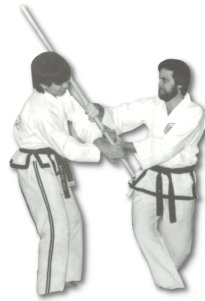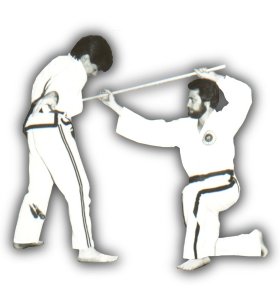The Jung Bong (Middle Staff) was used in several different
ways throughout Korean history. It was used as a walking
stick, to help carry heavy items such as water containers and
baskets of grain, and to ward off wild animals and bandits.
The illusive maneuvers of the Jung Bong's defenses may be
applied to all types of martial arts training.
The length of a Jung Bong varies from forty-two inches to
fifty inches. The physical characteristics of the Jung Bong
are quite unique. Some are made of hard wood, others of
flexible bamboo. The shaft could be completely smooth or it
may have notches at one or both ends to permit picking up
objects. These notches may also be used to inflict damage to
an opponent by cutting and slashing his face and limbs. Some
Jung Bong's are tapered at one or both ends. The Jung Bong
should be constructed to suit the individuals needs and
specification.
To increase the effectiveness of Jung Bong strikes the hips
are usually rotated in the direction of your strikes and
blocks. This helps put your body-weight into the force of
your strike or block. Using a "snapping" motion with your
wrists increases the speed of your Jung Bong movements. This
increased speed also adds to the power of your maneuvers.
Another often overlooked aspect of generating more speed and
power to Jung Bong movements is the rotation of the wrists.
Rather than simply shoving the tip of the Jung Bong toward
the aggressor, execute the same motion but this time rotate
the back hand as you slide the Jung Bong forward. This will
not only greatly increase the speed of your movements but the
power as well.
When retracting the Jung Bong, again use the wrist rotation
action to quickly withdraw. A quick withdraw is vital to
Jung Bong techniques. It lessens the chance of the aggressor
grabbing the Jung Bong. Quick withdrawal also enables you to
be prepared to block another attack or to be ready to execute
a counter-strike.
The Jung Bong may be used at a variety of ranges; long,
middle and short (close-quarters). By thrusting the Jung
Bong forward with one hand as the other hand remained
stationary, as the Jung Bong traveled forward, the range
could be extended and quickly retracted to again vary its
length.
The ends of the Jung Bong were used to strike, stab and jab
an aggressor. The ends could also be used at
close-quarters to trap the aggressor's arm and apply a
controlling technique.
 Being able to use the Jung Bong from a myriad of ranges
enables the practitioner to use a wide variety of varied
techniques. Positioning is an important factor when apply
defensive maneuvers. By stepping to your right rear of left
rear you can avoid an attack. This "distancing", while
placing you beyond the reach of an aggressor, puts him into
the striking range of your Jung Bong.
Being able to use the Jung Bong from a myriad of ranges
enables the practitioner to use a wide variety of varied
techniques. Positioning is an important factor when apply
defensive maneuvers. By stepping to your right rear of left
rear you can avoid an attack. This "distancing", while
placing you beyond the reach of an aggressor, puts him into
the striking range of your Jung Bong.
How far you step to the side or rear to evade an attack will
be a determining factor as to the type of defense you use.
You may, from one range, be able to strike the attacking arm
or leg then quickly follow up with a trust with the tip of
the Jung Bong.
From a slightly closer distance you might block with one end
of the Jung Bong then strike with the other end to disable
the aggressor. At a different range you could stun the
aggressor and apply a joint-locking technique to immobilize
the opponent.
Footwork is important to all aspects of martial arts physical
training but perhaps even more so when working with weapons.
When using the Jung Bong you should move at angles to avoid
an attack while at the same time putting yourself into a position
to quick counterattack your opponent. Use the forward
momentum of the aggressor to increase the power of your
strikes and blocks.
Being able to evade an attack while maintaining a safe distance
from the aggressor is one of the Jung Bong's strongest features.
Not only are you capable of avoiding being struck or grabbed,
but you are able to place yourself in a position of safety
while at the same time inflicting damage to the aggressor.
When using the Jung Bong your training should stress evasion
rather than direct contact. Place yourself at angles to
avoid his attack while at the same time counterattacking with
a strike.
 Focus your strikes on the attacking arm or leg and
specifically to sensitive areas of the body. The radial
nerve on the arm, the floating ribs, the head, the solar
plexus, etc. If you wish to only stun the aggressor then a
sharp jab or snapping blow will deter his initial attack. If
the danger to you is greater, as in the case of multiple
opponents or an armed aggressor, then a more forceful
technique may be called for.
Focus your strikes on the attacking arm or leg and
specifically to sensitive areas of the body. The radial
nerve on the arm, the floating ribs, the head, the solar
plexus, etc. If you wish to only stun the aggressor then a
sharp jab or snapping blow will deter his initial attack. If
the danger to you is greater, as in the case of multiple
opponents or an armed aggressor, then a more forceful
technique may be called for.
Evading by moving at different angles to the attacking force
in and of itself may not be enough to end the encounter. It
is just as important that you place yourself in a position by
which vital areas of the opponent's body are exposed. These
exposed targets now present you with the opportunity to stop
the opponent from being a threat.
The angles of evasion are common to all forms of martial
arts; Karate, Aikido, Jujitsu, Tae Kwon Do, Hapkido, Wu Shu,
etc. However, training with the Jung Bong often opens our
minds to the possibilities of using these angles more efficiently
than we have in the past. The Jung Bong frees us from
concerning ourselves with which type of hand strike or kick
to counter with since the Jung Bong itself is the instrument
with which we counterattack.
The ability to vary its length
also contributes to the option of seeing how we are able to
use long, middle and close-quarters techniques both with and
without the Jung Bong. The illusive defense of the Jung
Bong create a doorway for our minds to continue to refine our
defenses techniques with an almost limitless abundance of
variables